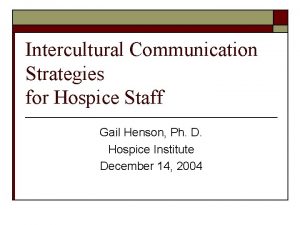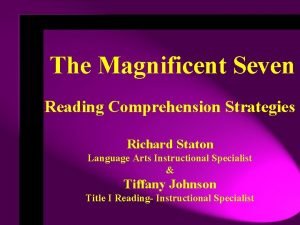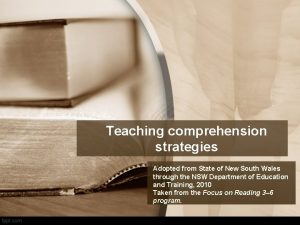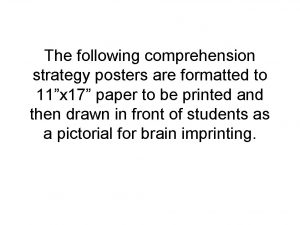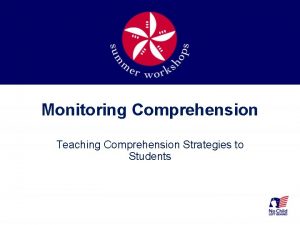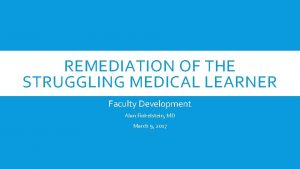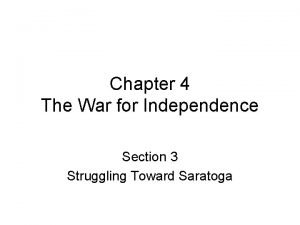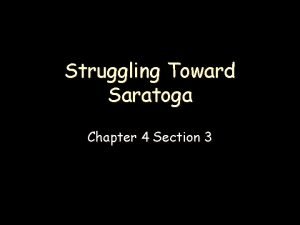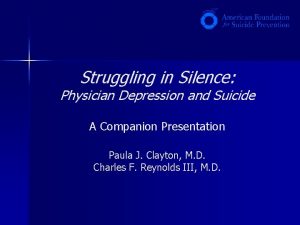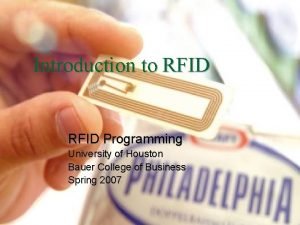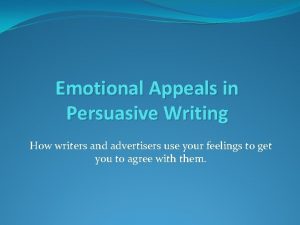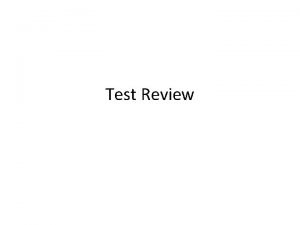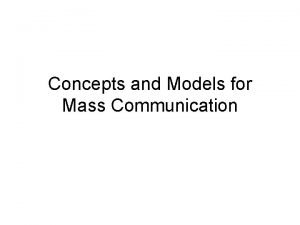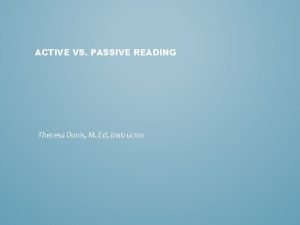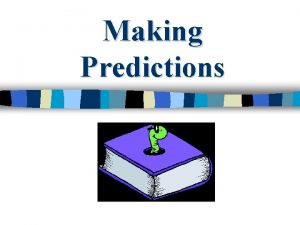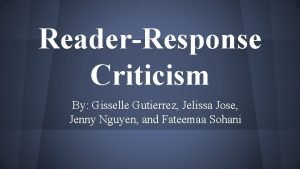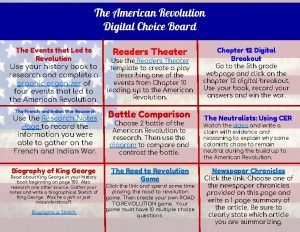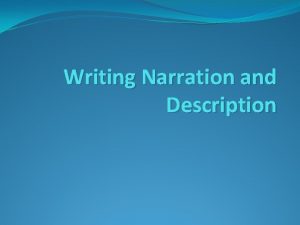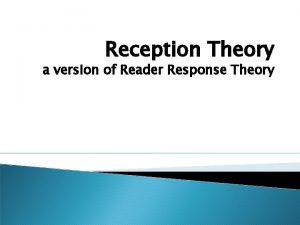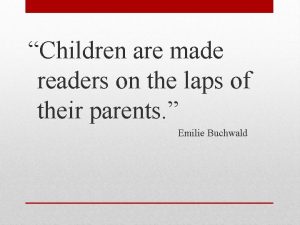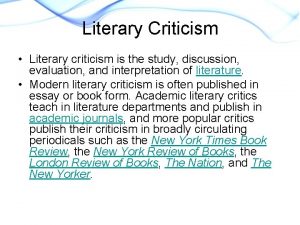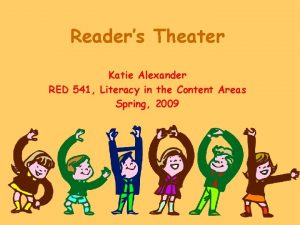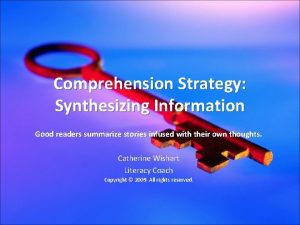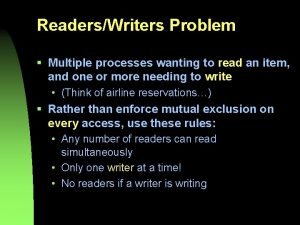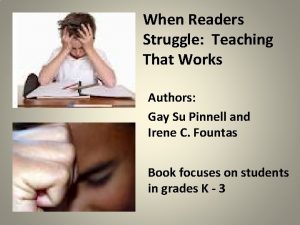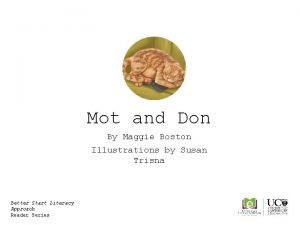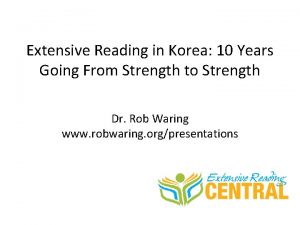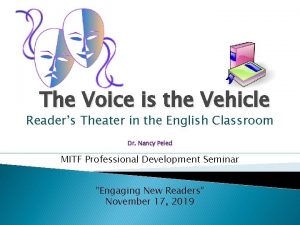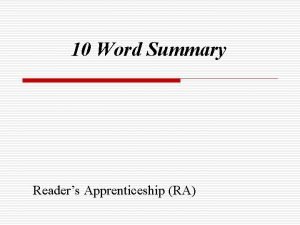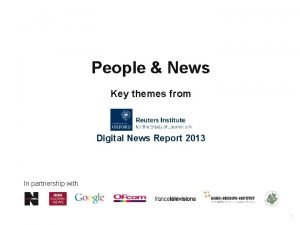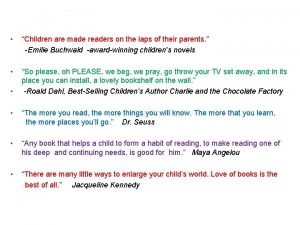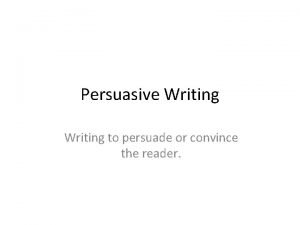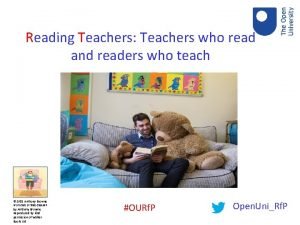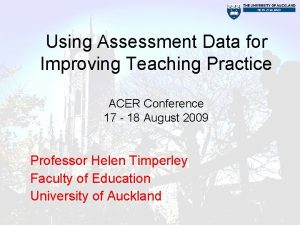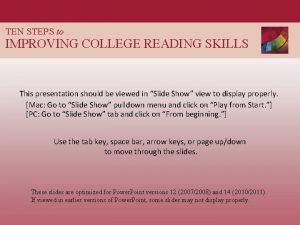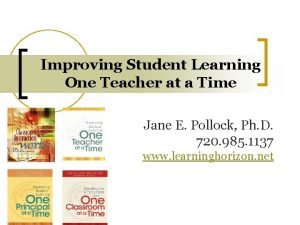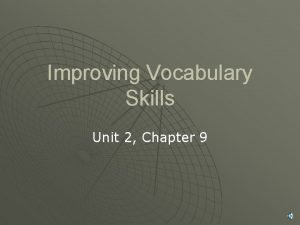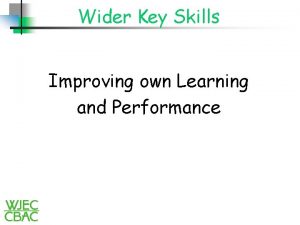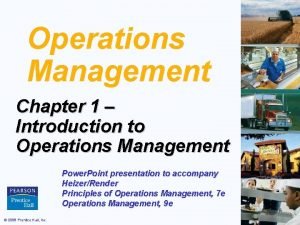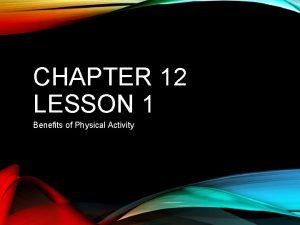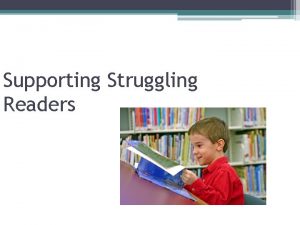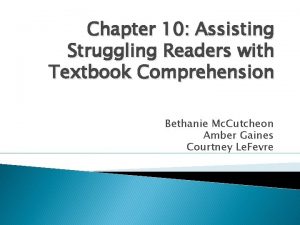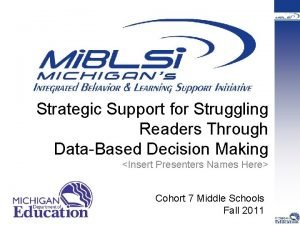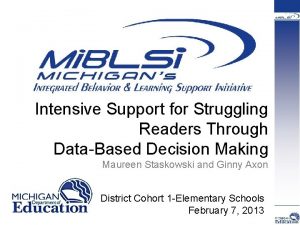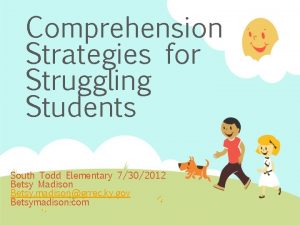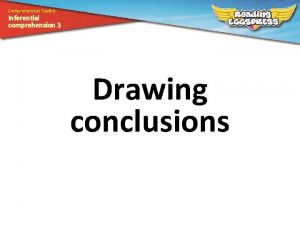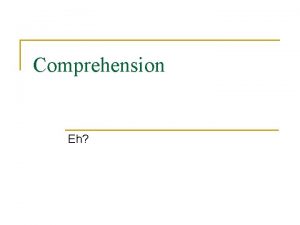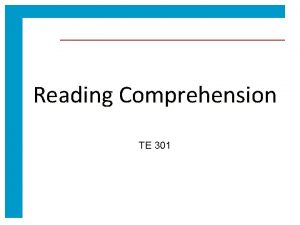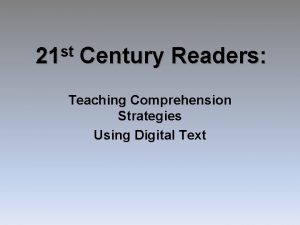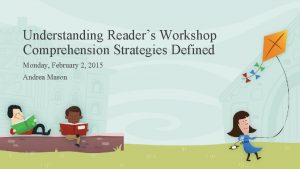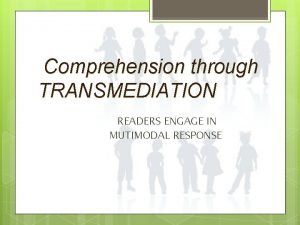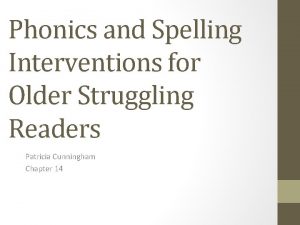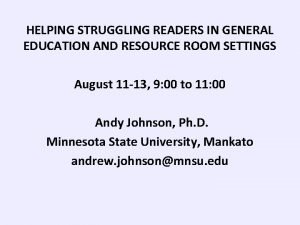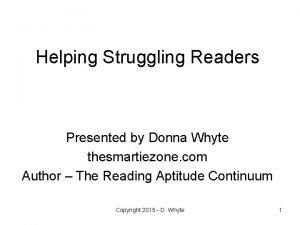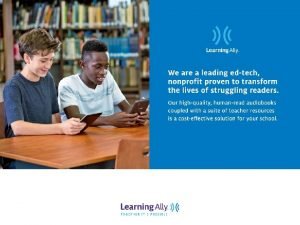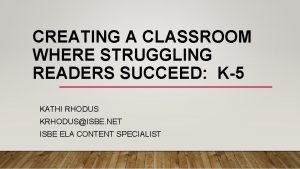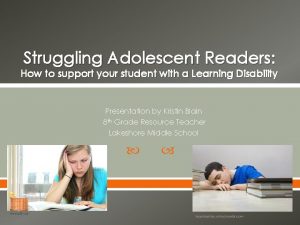Improving Comprehension Strategies of Struggling Adult Readers through
























































- Slides: 56

Improving Comprehension Strategies of Struggling Adult Readers through Conversational Trialogues with Auto. Tutor Art Graesser

Overview • Conversational Agents in Learning Environments • Dialogues, Trialogues, and N-alogs • Auto. Tutor Trialogues to Help Struggling Adult Readers

Why focus on adults with low literacy? • 1 out of 6 adults in the US do not read well enough for them to get a decent job (National Research Council, 2011; Programme for International Assessment of Adult Competencies, OECD, 2011). • Attendance is a problem because work schedules, childcare issues, and transportation difficulties (Greenberg, Reder, Rosen). • Comprehension training interventions for adult readers are few in number, with weak evidence they are helpful (Greenberg, Mellard, Sabatini). • AI technology can come to the rescue by improving comprehension training and providing intelligent support, 24 -7! Graesser, A. C. , Greenberg, D. , Olney, A. M. , & Lovett, M. W. (in press). Educational technologies that support reading comprehension for adults who have low literacy skills. In D. Perin (Ed). Wiley adult literacy handbook. New York: Wiley.

Organizations committed to improve adult literacy Commission on Adult Basic Education: http: //www. coabe. org/ Institute of Education Sciences: http: //ies. ed. gov/ Literacy Information and Communication System: http: //lincs. ed. gov/ Office of Career, Technical, and Adult Education: http: //www 2. ed. gov/about/offices/list/ovae/index. html Pro. Literacy: http: //www. proliteracy. org/ VALUEUSA: http: //www. valueusa. org/

Daphne Greenberg Jan Frijters Art Graesser Maureen Lovett Lee Branum-Martin Andrew Olney

Conversational Agents in Learning Environments Graesser, A. C. , Rus, V. , Hu, X. (2017). Instruction based on tutoring. In R. E. Mayer and P. A. Alexander (Eds. ), Handbook of Research on Learning and Instruction (pp. 460 -482). New York: Routledge Press. Nye, B. D. , Graesser, A. C. , & Hu, X. (2014). Auto. Tutor and family: A review of 17 years of natural language tutoring. International Journal of Artificial Intelligence in Education, 24, 427– 469.

Adaptive Intelligent Conversational Agents STEVE Auto. Tutor Trialogs with ALEKS algebra Guru (biology) Deep. Tutor (physics) Tactical Language and Culture System i. START (reading) Betty’s Brain Herman-the-Bug Mission Rehearsal

Memphis Intelligent Conversational Agents Auto. Tutor (computer literacy) Auto. Tutor (reading comprehension) ARIES (scientific reasoning) Auto. Tutor (with ALEKS algebra) HURA Advisor (research ethics) Electronix. Tutor Guru (biology) Deep. Tutor (physics) Personal Assistant for Lifelong Learning (PAL 3)

Functions of Conversational Agents • • Help when initiated by the user Navigational guide Modeling action, thought, and social interaction Adaptive intelligent conversational dialog Staging arguments to prompt deeper learning Staging scenarios for assessment Many roles: peers, tutor, mentor

Emotions During Learning (Graesser, Baker, Craig, D’Mello, Lehman, Rodrigo) Boredom (23%) Flow (28%) Confusion (25%) Delight (4%) Frustration (16%) Surprise (4%)

Measures collected at different grain sizes 1) 2) 3) 4) 5) 6) 7) 8) Lessons attempted and completed Performance in each lesson Selecting answers to multiple choice questions Semantic matches between natural language input and expectations or misconceptions Initiative by asking questions, selecting tasks, and performing unprompted actions Fluency of language and action Engagement by response time patterns & coupling with item difficulty Emotions (confusion, frustration, boredom, etc. )

Meta-analyses on Intelligent Tutoring Systems Effect Size Kulik & Fletcher (2016) 50 comparisons 0. 66 Van. Lehn (2011) Ma, Adesope, Nesbit, & Liu (2014) 54 comparisons, STEM 107 comparisons 0. 58 0. 43 Steenbergen-Hu & Cooper (2014) 39 comparisons, college 0. 35 Steenbergen-Hu & Cooper (2013) 26 comparisons, math, K 12 0. 05 Ritter, Kulikowich, Lei, et al. 2007) Cognitive Tutor, math, WWCH 0. 38 Fletcher & Morrison (2012) Digital Tutor (1 -study, N = 26) 3. 17 Nye, Graesser, & Hu (2014), Graesser (2016) Auto. Tutor (science, dozens of studies) 0. 60 to 0. 80

Generalized Intelligent Framework for Tutoring Army Research Lab and University of Memphis www. gifttutoring. org Sottilare, R. , Graesser, A. , Hu, X. , & XXXX (2013 -2018). Design Recommendations for Intelligent Tutoring Systems. • Learner modeling (2013) • Instructional strategies (2014) • Authoring tools (2015) • Domain knowledge (2016) • Assessment (2017) • Teams (2018) • Self-improving systems (2019)

Dialogues and Trialogues Graesser, A. C. (2016). Conversations with Auto. Tutor help students learn. International Journal of Artificial Intelligence in Education, 26. 124 -132. Graesser, A. C. , Forsyth, C. , & Lehman, B. (2017). Two heads are better than one: Learning from agents in conversational trialogues. Teachers College Record, 119, 1 -20.

Expectation & Misconception-Tailored Dialog • • • Tutor asks question that requires explanatory reasoning Student answers with fragments of information, distributed over multiple turns Tutor analyzes the fragments of the explanation – Compares to a list of expected good idea units (via LSA and Regular expressions) – Compares to a list of expected errors and misconceptions Tutor posts goals & performs dialog acts to improve explanation – Fills in missing expected good idea units (one at a time) – Corrects expected errors & misconceptions (immediately) Tutor handles periodic sub-dialogues – Student questions – Student meta-communicative acts (e. g. , What did you say? )

Speech Act Hierarchy Human-Human kappa =. 80 Human-Computer kappa =. 73


• Managing One Auto. Tutor Turn Short feedback on the student’s previous turn Positive feedback: “Yeah” “Right!” Neutral feedback: “Okay” “Uh huh” Negative feedback: “No” “Not quite” • Advance the dialog by one or more dialog moves that are connected by discourse markers • End turn with a signal that transfers the floor to the student – Question – Prompting hand gesture – Head/gaze signal

Challenges • Semantic matches are pretty good but not perfect Understanding is limited • Semantic blur between expectations and misconceptions Some errors in feedback • Learners expect full credit when they express a couple of juicy words instead of a sufficiently articulated statement The can be irritation or frustration • High verbal or knowledgeable learners read printed conversation faster than listening to an agent • Limited ability to handle student questions and requests

Adaptive Trialogues Expert Fellow Student Vicarious St ac h Human Learner Te ar d in g an d

Trialogues in Literacy and Numeracy Xiangen Hu, University of Memphis

Advantages of Trialogues • Two agents can model desired social interactions • Two agents can disagree, stage an argument, and create cognitive disequilibrium • A peer agent can echo a learner’s contribution in a well articulated language, so: § Agent gets blame for a bad answer § Agent and learner gets credit for a good answer § Learner sees a well articulated response. • Peer agent model good inquiry and receive good responses from the tutor agent

23

Trialogue (English Language Skills) Agent Utterance Lisa: Hey, Ron, you need to leave your water outside. I'm going to go talk to my friends. I'll see you guys inside. Ron: Why did she tell me I have to leave my water outside, Tim? Human (Tim): I don’t know. Ron: Human (Tim): Tim, why can't I drink water? The books may get wet. Lisa: Why do you still have your water bottle, Ron? Look at rule number 2. We cannot get in the library with food or drink. 24

Auto. Tutor Trialogues to Help Struggling Adult Readers


Intervention to Improve Reading for Adults • Adults who read at grade levels 3 -7. 9 • 100 instructional hours • 2 times weekly • 2 -3 hours per duration • Atlanta and Toronto areas • 253 in the intervention • Comparison to business as usual

Adult PACES Comprehension Program • P = Predicting purpose with text signals and key information. • A = Acquiring vocabulary with context clues. • C = Clarifying common sources of confusion with clarifying questions. • E = Evaluating and elaborating through questioning. • S = Summarizing with text maps. Lovett, M. W. , Lacerenza, L. , De Palma, M. , & Frijters, J. C. (2012). Evaluating the efficacy of remediation for struggling readers in high school. Journal of Learning Disabilities. 45, 151 -169.

Multilevel theoretical framework of discourse comprehension • • • Words Syntax Textbase • Explicit ideas (propositions) • Referential cohesion Situation model • Causal, intentional, temporal, spatial, logical relationships • Connectives, signaling words Genre and rhetorical structure Pragmatic communication Graesser, A. C. , & Mc. Namara, D. S. (2011). Computational analyses of multilevel discourse comprehension. Topics in Cognitive Science, 3, 371 -398. Also Goldman, Kintsch, Perfetti…

Home Web Page

Scope of Lessons

Database for Instructor Lessons Adults Performance

More Details about Auto. Tutor for CSAL • • 35 lessons on comprehension 20 -60 minutes each Summary Nugget Conversational Training Cover theoretical components and PACES curriculum Conversation patterns Agents in trialogues generate questions, hints, feedback, corrections, explanations, and guidance on using the system Conversation modes: Testing, helping the peer, game competition Minimal natural language input from adult Multiple media Practical texts and tasks for adults

Auto. Tutor Trialogue Teacher Agent: Cristina Peer Agent: Jordan Participants read text and answer question

Tutorial On Digital Literacy

Discourse Formality Informational Genre + High Cohesion + Complex Syntax + Abstract Words Cohmetrix. com Zhiqiang Cai

Coh-Metrix Formality Scores as a Function of Genres and Grade Levels Language Arts Social. Studies Science Formality 0. 4 0. 2 0. 0 -0. 2 -0. 4 -0. 6 -0. 8 K-1 2 -3 4 -5 6 -8 9 -10 11 CCR Grade Level Graesser, A. C. , Mc. Namara, D. S. , Cai, Z. , Conley, M. , Li, H. , & Pennebaker, J. ( 2014). Coh-Metrix measures text characteristics at multiple levels of language and discourse. Elementary School Journal. 115, 210 -229.

Types of Adaptivity • Lessons start out at a medium level of difficulty and branch to easy or hard depending on performance. • In the inner loop (Van. Lehn, 2006), the conversational moves depend on the input of the adult learner. • In the game competitions, the peer agent’s actions always end up losing to the adult learner at the end.

Intervention Design I. Pretest on dozens of measures II. Intervention (100 hours) III. Posttest with dozens of measures Three comprehension measures • • • Woodcock-Johnson Sara (Educational Testing Service) Lexia (formerly Rapid)

Study on Adult Readers (N=253) GENDER Female 4 month intervention on 26 lessons 25% 75% Toronto n = 118 • Age: 16 -69 • Reading Grade Level: 3. 0 – 7. 9 Atlanta n = 135 Male

Overall Results of Auto. Tutor • Completion of lessons • 26 lessons were used in the analysis • 68. 2% of lessons attempted • 55. 3% of the lessons completed • Performance in answering questions • 68% answered correctly on first attempt • 78% likelihood of branching to difficult texts rather than easy texts/items after performing on medium texts/items • 32. 8 seconds per question

Cluster Analysis Features ● Performance time & accuracy crossed with four levels of reading comprehension (Words, Textbase, Situation model, Rhetorical structure) Method ● K-means clustering VS hierarchical agglomerative clustering (Connectivity, Silhouette Width, Dunn Index) ● Hierarchical clustering performed better Fang, Y. , Shubeck, K. T. , Lippert, A. , Cheng, Q. , Shi, G. , Feng, S. , Gatewood, J. , Chen, S. , Cai, Z. , Pavlik, P. I. , Frijters, J. C. , Greenberg, D. , Graesser, A. C. (2018). Clustering the Learning Patterns of Adults with Low Literacy Interacting with an Intelligent Tutoring System. In K. E. Boyer & M. Yudelson (Eds. ), Proceedings of the 11 th International Conference on Educational Data Mining (pp. 348 -354). Buffalo, NY: Educational Data Mining Society.

Four Clusters of Readers based on Auto. Tutor Response Times and Accuracy 1. Struggling readers showed minimal gains and may be wheel spinning. Slow plus inaccurate. 2. Under-engaged readers don’t spend quite enough time that they need. Fast and lower accuracy. 3. Conscientious readers are slow and higher accuracy. 4. Higher performing readers are relatively fast and accurate.

Accuracy as a Function of Theoretical Level and Reader Cluster Word Textbase Situation Model Rhetorical Structure Proportion Correct 0. 8 0. 7 0. 6 0. 5 0. 4 Higher Performing Conscientious Struggling Underengaged

Time per Question (seconds) as a Function of Theoretical Level and Reader Cluster Word Textbase Situation Model Rhetorical Structure Seconds/Question 60 50 40 30 20 Higher Performing Conscientious Struggling Underengaged

Effect Sizes (posttest minus pretest) on Learning Gains as a Function of Reader Cluster Woodcock-Johnson Lexia Sara (ETS) Composite 0. 7 0. 6 0. 5 0. 4 0. 3 0. 2 0. 1 0 -0. 1 Higher Performing Conscientious Struggling Underengaged

The four clusters of readers show very different profiles 1. Struggling readers showed minimal gains and may be wheel spinning. The intervention is beyond their zone of proximal development. 2. Under-engaged readers need to be encouraged to spend more time concentrating or otherwise be motivated more. 3. Conscientious readers are the major beneficiaries. 4. Higher performing readers may benefit from more challenge and be encouraged to increase reading activities.

Item Analyses: Mixed-effects Models (Ying Fang) • Predictor variables – – – Text formality score Question depth level (Bloom’s taxonomy) Answer length (log of number of words in options) • Dependent variables – – Time on question in seconds Correctness of answer to question • Random effects – – Participants Texts

Predicting time in 1 st attempts

Results on Time and Accuracy of Question Items First Attempt Time Text Formality Question Depth + + + - Subsequent Attempt Time First Attempt Accuracy Subsequent Attempt Accuracy - Answer Length

Disengagement Tracing System (Su Chen) Algorithm Flow Chart

Upshot of Question Item Analyses • Identify disengagement time spans of individual readers • Quickly classify individual readers into one of the four reader clusters (struggling, under-engaged, conscientious, higher performers) • Design Auto. Tutor to select materials and trialogue moves that are sensitive to these characteristics

Immediate Next Steps • Auto. Tutor in the Wild • Explore how much human instructor scaffolding is needed? • Scaling up Auto. Tutor for: adult literacy centers workforce colleges, universities, Department of Defense training

Long-term Horizon with AI • Build a more adaptive Auto. Tutor – Sensitivity to engagement and reading clusters – Sensitivity to interests of the reader (Andrew Olney) • Speech recognition and mobile devices • Social connections through social media: – Human connections with peers and instructors – Will they believe intelligent bots? • Integration with Geographical Information Systems – You are near a literacy center, bookstore, library… – You like Chinese food. What do you think about this restaurant?

Faculty Investigators Daphne Greenberg, Georgia State University Zhiqiang Cai, M. S, University of Memphis Jan Frijters, Brock University Art Graesser, University of Memphis Xiangen Hu, University of Memphis Hongli Li, Georgia State University Maureen Lovett, University of Toronto Lee Branum-Martin, Georgia State University Robin Morris, Georgia State University Andrew Olney, University of Memphis Partners Christopher D. Barr, University of Houston Larry Condelli, American Institutes for Research Stephanie M. Cronen, American Institutes for Research Project Managers Whitney Baer, University of Memphis Anne Lippert, University of Memphis Dina Schwam, Georgia State University Amani Talwar, Georgia State University Others 17 Graduate Students 22 Staff Members 25 Expert Consultants 74 Research Assistants

Thank you! graesser@memphis. edu
 The outsiders adapted for struggling readers
The outsiders adapted for struggling readers Critical reading meaning
Critical reading meaning Strategies for improving intercultural communication
Strategies for improving intercultural communication Seven reading strategies
Seven reading strategies Teaching comprehension strategies nsw
Teaching comprehension strategies nsw Comprehension strategy posters
Comprehension strategy posters Super 6 strategies
Super 6 strategies Directed reading thinking activity
Directed reading thinking activity Remediation of the struggling medical learner
Remediation of the struggling medical learner Chapter 4 section 3 struggling toward saratoga
Chapter 4 section 3 struggling toward saratoga Struggling toward saratoga section 3
Struggling toward saratoga section 3 Struggling in silence
Struggling in silence The night of the scorpion
The night of the scorpion Advantages of timber conversion
Advantages of timber conversion Through one man
Through one man Tarnow fletcher furcation classification
Tarnow fletcher furcation classification Bar code rfid houston
Bar code rfid houston Language features of news item text
Language features of news item text Persuasive appeals
Persuasive appeals Paine compares tyranny to hell in order to
Paine compares tyranny to hell in order to Concepts in mass communication
Concepts in mass communication What is passive reading
What is passive reading Good readers make predictions by
Good readers make predictions by Reader response criticism
Reader response criticism American revolution readers theater
American revolution readers theater Vivid writing examples
Vivid writing examples Reading techniques and strategies
Reading techniques and strategies Civil war readers theater
Civil war readers theater Readers goal in narration
Readers goal in narration Transactional reader response theory
Transactional reader response theory Children are made readers on the laps of their parents
Children are made readers on the laps of their parents Maggie boston readers
Maggie boston readers Feminist criticism meaning
Feminist criticism meaning Where the wild things are readers theater
Where the wild things are readers theater Reading comprehension synthesizing
Reading comprehension synthesizing Readers writers problem
Readers writers problem When readers struggle
When readers struggle Maggie boston readers
Maggie boston readers To persuade to entertain to inform
To persuade to entertain to inform Korean graded readers
Korean graded readers Where the wild things are readers theater
Where the wild things are readers theater 10 word summary
10 word summary Online readers
Online readers Children are made readers on the laps of their parents
Children are made readers on the laps of their parents Persuading the reader
Persuading the reader Teachers as readers
Teachers as readers Improving student learning one teacher at a time
Improving student learning one teacher at a time Using assessment data for improving teaching practice
Using assessment data for improving teaching practice Improving software economics set 1
Improving software economics set 1 Nist cybersecurity framework roadmap
Nist cybersecurity framework roadmap Ten steps to improving college reading skills answer key
Ten steps to improving college reading skills answer key Improving public sector efficiency
Improving public sector efficiency Improving student learning one teacher at a time
Improving student learning one teacher at a time Improving vocabulary skills chapter 9
Improving vocabulary skills chapter 9 Improving own learning and performance examples
Improving own learning and performance examples Starbucks inputs and outputs
Starbucks inputs and outputs A physical education chapter 12
A physical education chapter 12


